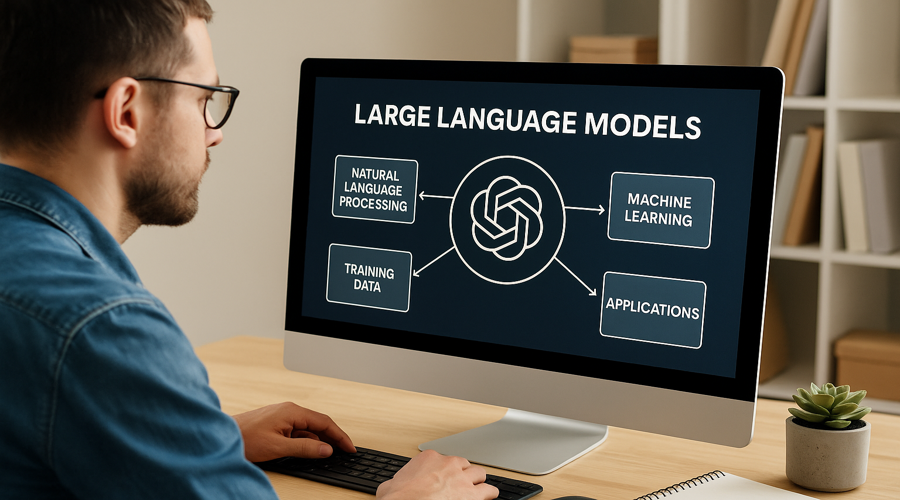Artificial intelligence (AI) has moved from concept to cornerstone, driving transformation across industries. Among its most powerful tools are large language models (LLMs), which help organisations automate tasks, manage information, and enhance customer interactions. This article explores how LLMs work, their business value, limitations, and key trends.
What Are Large Language Models?
In simple terms, they are advanced AI systems trained on massive datasets to understand and generate human language with impressive fluency. Unlike traditional language tools, LLMs handle a wide range of tasks—from summarising reports to powering conversational AI—often with minimal customisation. What makes them “large”? The size refers to the number of parameters—the internal variables the model uses to learn patterns and context. The more parameters, the better the model captures nuance, enabling sophisticated outputs from legal summaries to technical writing.
How Do Large Language Models Work?
LLMs are built on Transformer architecture, a breakthrough that allows models to process all words in a sentence simultaneously. Through self-attention mechanisms, the model weighs each word’s relevance to others, improving contextual understanding.
Before processing, text is broken into tokens—small units like words or subwords—which are converted into numeric vectors. These pass through deep neural networks, layer by layer, to generate meaningful, contextually accurate output. This architecture underpins the versatility of LLMs, enabling tasks from casual conversation to regulatory compliance analysis.
Types of LLMs: Open Source vs Proprietary
The LLM landscape includes both open-source models (e.g., LLaMA 3, Mistral) and proprietary models (e.g., GPT-4o, Claude 3). Open-source options offer flexibility and community-driven innovation. Proprietary models provide premium performance and enterprise-grade support.
In some cases, smaller language models (SLMs) are enough—especially when there are limits on resources or speed. But for tasks that need deeper understanding and more complex responses, large language models (LLMs) are the better option.
Benefits and Applications of LLMs
LLMs deliver strategic advantages across industries:
- Text Generation and Summarisation: Automate content creation, reporting, and knowledge extraction at scale.
- Conversational AI: Nexmira’s NexAgentix uses LLMs to power intelligent, personalised customer interactions—improving engagement while reducing operational costs.
- Code Assistance: Tools like GitHub Copilot, underpinned by LLMs, accelerate software development by suggesting code, detecting errors, and generating functions.
Enterprise Use Cases:
- Healthcare: Clinical documentation, predictive diagnostics.
- Education: Personalised tutoring, curriculum support.
- Legal: Contract analysis, regulatory research.
At Nexmira Services, we deploy LLM-driven solutions tailored to each sector’s unique needs—helping businesses streamline workflows, reduce manual effort, and scale knowledge management.
Challenges and Limitations
Despite their strengths, LLMs come with challenges:- Computational Costs: Training and deploying LLMs require significant processing power and infrastructure.
- Bias and Ethics: LLMs inherit biases from training data. At Nexmira, we implement bias monitoring and ethical safeguards to mitigate risks, particularly in sensitive domains.
- Security Vulnerabilities: Issues like prompt injection and data leakage require robust security measures. Nexmira integrates protective controls—including input sanitisation and audit mechanisms—to ensure safe deployment aligned with Australian data standards.
Future Trends and Innovations
Emerging trends to watch include:
- Multi-Modal AI: Combining text, images, and audio in unified models.
- Real-Time Reasoning: Adaptive models capable of updating outputs on-the-fly.
- Open Source Growth: Rapid innovation driven by global developer communities.
For forward-thinking organisations, adopting these innovations early can unlock new competitive advantages.
Conclusion: Strategic Implications
Understanding What Are Large Language Models and LLMs is no longer optional for businesses embracing AI-driven transformation. These technologies offer unmatched potential to automate, enhance, and personalise operations.
At Nexmira product, we empower clients to leverage LLMs strategically—combining cutting-edge AI with ethical safeguards, security measures, and domain expertise. As AI continues evolving, organisations that integrate LLMs thoughtfully will lead in innovation, efficiency, and customer impact.
Frequently asked questions:


